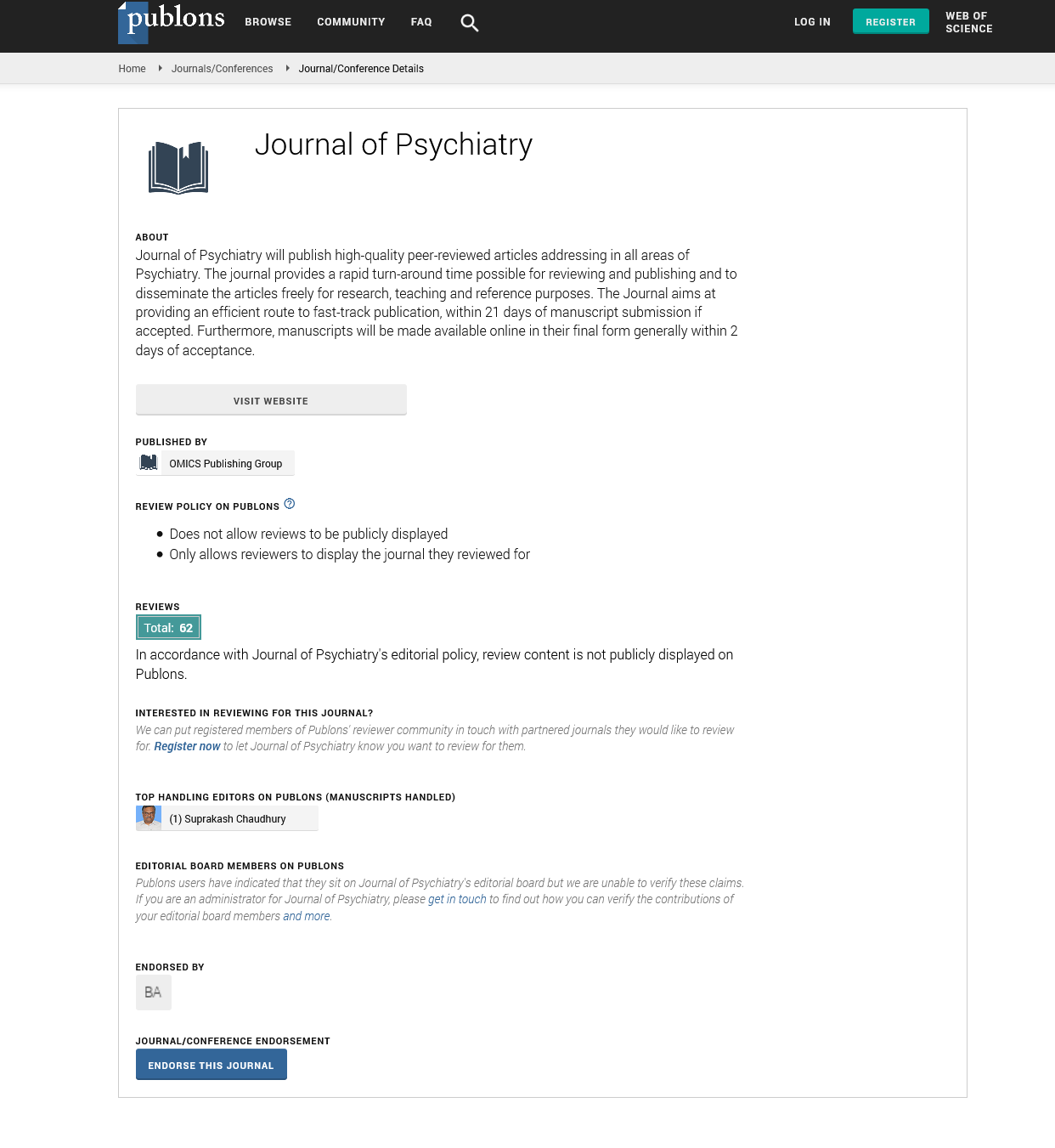Indexed In
- RefSeek
- Hamdard University
- EBSCO A-Z
- OCLC- WorldCat
- SWB online catalog
- Publons
- International committee of medical journals editors (ICMJE)
- Geneva Foundation for Medical Education and Research
Useful Links
Share This Page
Open Access Journals
- Agri and Aquaculture
- Biochemistry
- Bioinformatics & Systems Biology
- Business & Management
- Chemistry
- Clinical Sciences
- Engineering
- Food & Nutrition
- General Science
- Genetics & Molecular Biology
- Immunology & Microbiology
- Medical Sciences
- Neuroscience & Psychology
- Nursing & Health Care
- Pharmaceutical Sciences
Commentary - (2023) Volume 26, Issue 6
The Cerebellum's Role in Social Cognition and Emotion Regulation
Kevin Olivito*Received: 02-Jun-2023, Manuscript No. JOP-23-21933; Editor assigned: 05-Jun-2023, Pre QC No. JOP-23-21933(PQ); Reviewed: 19-Jun-2023, QC No. JOP-23-21933; Revised: 26-Jun-2023, Manuscript No. JOP-23-21933(R); Published: 03-Jul-2023, DOI: 10.35248/2378-5756.23.26.603
Description
The cerebellum is a brain structure that is traditionally associated with motor control, coordination, and learning. However, in recent years, there has been growing evidence that the cerebellum is also involved in higher cognitive and emotional functions, such as social cognition and emotion regulation. Social cognition refers to the ability to understand and interact with others, while emotion regulation refers to the ability to modulate and cope with one’s own and others’ emotions. The cerebellum is connected to various cortical and subcortical regions that are implicated in social cognition and emotion regulation, such as the prefrontal cortex, the temporal cortex, the amygdala, and the insula. These connections form functional networks that enable the cerebellum to participate in the processing and integration of social and emotional information.
The cerebellum may contribute to social cognition and emotion regulation by providing predictive, feedback, and error-correction signals that optimize the performance and adaptation of these functions. Several studies have investigated the role of the cerebellum in social cognition and emotion regulation using different methods and measures. Some of these studies have used neuroimaging techniques, such as functional Magnetic Resonance Imaging (fMRI) or Positron Emission Tomography (PET), which can measure the brain activity or metabolism of different regions during various tasks or stimuli. Other studies have used neuropsychological methods, such as lesion studies or stimulation studies, which can examine the effects of damage or modulation of specific regions on behavior or performance.
Involvement of cerebellum in various aspects of social cognition and emotion regulation
Theory of mind: This is the ability to infer the mental states, such as beliefs, intentions, emotions, and perspectives, of one and others. Studies have shown that the cerebellum is activated during theory of mind tasks, such as reading stories or cartoons that involve metallizing or perspective taking. Moreover, patients with cerebellar lesions or degeneration show impairments in theory of mind tasks, such as false belief or irony comprehension.
Empathy: This is the ability to share and understand the emotions of others. Studies have shown that the cerebellum is activated during empathy tasks, such as viewing faces or scenes that express different emotions. Furthermore, patients with cerebellar lesions or degeneration show deficits in empathy tasks, such as recognizing facial expressions or emotional prosody.
Moral reasoning: This is the ability to judge the morality or immorality of actions or situations based on moral principles or values. Studies have shown that the cerebellum is activated during moral reasoning tasks, such as evaluating moral dilemmas or scenarios that involve harm or fairness. Additionally, patients with cerebellar lesions or degeneration show alterations in moral reasoning tasks, such as being more utilitarian or less deontological.
Emotion regulation: This is the ability to modulate and cope with one’s own and others’ emotions in an adaptive way. Studies have shown that the cerebellum is activated during emotion regulation tasks, such as reappraising or suppressing negative emotions. Moreover, patients with cerebellar lesions or degeneration show difficulties in emotion regulation tasks, such as being more prone to anxiety, depression, anger, or impulsivity.
The role of the cerebellum in social cognition and emotion regulation has important implications for the understanding and treatment of various neuropsychiatric disorders that affect these functions, such as Autism Spectrum Disorder (ASD), schizophrenia, bipolar disorder, Major Depressive Disorder (MDD), Post-Traumatic Stress Disorder (PTSD), Obsessive- Compulsive Disorder (OCD), or Attention-Deficit Hyperactivity Disorder (ADHD). By elucidating the neural mechanisms and pathways that underlie the cerebellar contribution to social cognition and emotion regulation, it may be possible to develop novel diagnostic tools, therapeutic interventions, or preventive strategies for these disorders. For example, some studies have suggested that cerebellar stimulation or modulation may enhance social cognition and emotion regulation in patients with ASD, schizophrenia, MDD, or PTSD. However, more research is needed to confirm the efficacy and safety of these approaches, as well as to identify the optimal parameters and targets for different populations and outcomes. Future studies should also use more standardized and validated measures of social cognition and emotion regulation, as well as employ longitudinal designs, multimodal neuroimaging techniques, molecular markers, and animal models to better understand the causal mechanisms and long-term effects of cerebellar involvement in social cognition and emotion regulation.
Citation: Olivito K (2023) The Cerebellum's Role in Social Cognition and Emotion Regulation. J Psychiatry. 26:603.
Copyright: © 2023 Olivito K. This is an open access article distributed under the terms of the Creative Commons Attribution License, which permits unrestricted use, distribution, and reproduction in any medium, provided the original author and source are credited.

